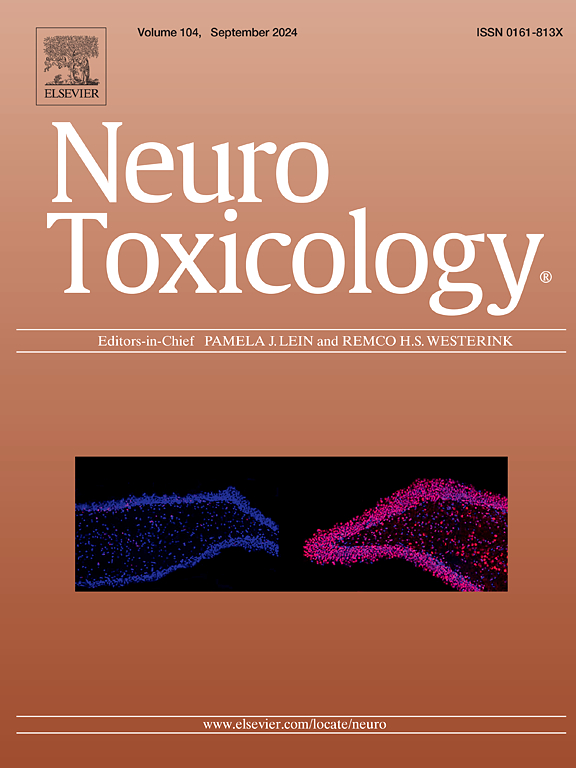Hexavalent chromium neurotoxicity in Caenorhabditis elegans targeted GABAergic, cholinergic, and dopaminergic neurons, and contributed to an aged phenotype
IF 3.9
3区 医学
Q2 NEUROSCIENCES
引用次数: 0
Abstract
Hexavalent chromium [Cr(VI)] is a ubiquitous environmental pollutant and potent toxicant. Cr(VI) exposure impacts millions of people around the world, primarily through inhalation or ingestion. Such exposures are best known for contributing to cancers of the lung, sinus, and nasal passage, damage to kidneys and liver, and contact dermatitis. Growing evidence indicates exposure contributes to neurological conditions, but knowledge gaps persist regarding Cr(VI) neurotoxicity. Human studies report Cr(VI) contributes to autism spectrum disorders, motor neuron disease, olfactory dysfunction, and impaired memory. However, knowledge of specific targets for Cr(VI) in the brain is limited to reports of regional accumulation (greatest effects reported in the rodent hippocampus, hypothalamus, and pituitary gland), while cell-specific effects remain unknown. Caenorhabditis elegans is a useful high-throughput model, frequently used for metals neurotoxicity. Here, we characterize a C. elegans model to address knowledge gaps in Cr(VI) neurotoxicity. All Cr(VI) concentrations tested were sublethal, and we estimate bioaccumulation of Cr in worms was ∼1e10−8% of the administered dose after a 24-hour exposure. Cr(VI) initially targeted GABAergic neurons after a 6-hour exposure, while cholinergic, dopaminergic, and GABAergic neurons were affected following a 24-hour exposure. Impacts on behaviors were consistent with neurodegeneration. Further, Cr(VI) exacerbated gut autofluorescence in worms, indicative of accelerated biological aging. These data collectively address key knowledge gaps, identifying key neuronal targets and informing potential mechanisms of neurotoxicity.
六价铬对秀丽隐杆线虫gaba能、胆碱能和多巴胺能神经元的神经毒性,并导致衰老表型。
六价铬[Cr(VI)]是一种普遍存在的环境污染物和强毒物。六价铬暴露主要通过吸入或摄入影响全世界数百万人。众所周知,这种暴露会导致肺癌、鼻窦和鼻道癌、肾脏和肝脏损伤以及接触性皮炎。越来越多的证据表明,接触会导致神经系统疾病,但关于铬(VI)神经毒性的知识差距仍然存在。人类研究报告称,Cr(VI)与自闭症谱系障碍、运动神经元疾病、嗅觉功能障碍和记忆受损有关。然而,对Cr(VI)在大脑中的特异性靶点的了解仅限于区域积累的报道(在啮齿动物的海马、下丘脑和垂体中报道了最大的作用),而细胞特异性作用仍然未知。秀丽隐杆线虫是一种有用的高通量模型,常用于金属神经毒性研究。在这里,我们描述了秀丽隐杆线虫模型,以解决Cr(VI)神经毒性的知识空白。所有测试的Cr(VI)浓度都是亚致死的,我们估计24小时暴露后,蠕虫体内Cr的生物蓄积量约为给药剂量的1e10-8%。暴露6小时后,Cr(VI)最初靶向gabaergy神经元,而暴露24小时后,胆碱能、多巴胺能和gabaergy神经元受到影响。对行为的影响与神经退行性变一致。此外,Cr(VI)加剧了蠕虫肠道自身荧光,表明生物老化加速。这些数据共同解决了关键的知识空白,确定了关键的神经元靶点,并为神经毒性的潜在机制提供了信息。
本文章由计算机程序翻译,如有差异,请以英文原文为准。
求助全文
约1分钟内获得全文
求助全文
来源期刊

Neurotoxicology
医学-毒理学
CiteScore
6.80
自引率
5.90%
发文量
161
审稿时长
70 days
期刊介绍:
NeuroToxicology specializes in publishing the best peer-reviewed original research papers dealing with the effects of toxic substances on the nervous system of humans and experimental animals of all ages. The Journal emphasizes papers dealing with the neurotoxic effects of environmentally significant chemical hazards, manufactured drugs and naturally occurring compounds.
 求助内容:
求助内容: 应助结果提醒方式:
应助结果提醒方式:


